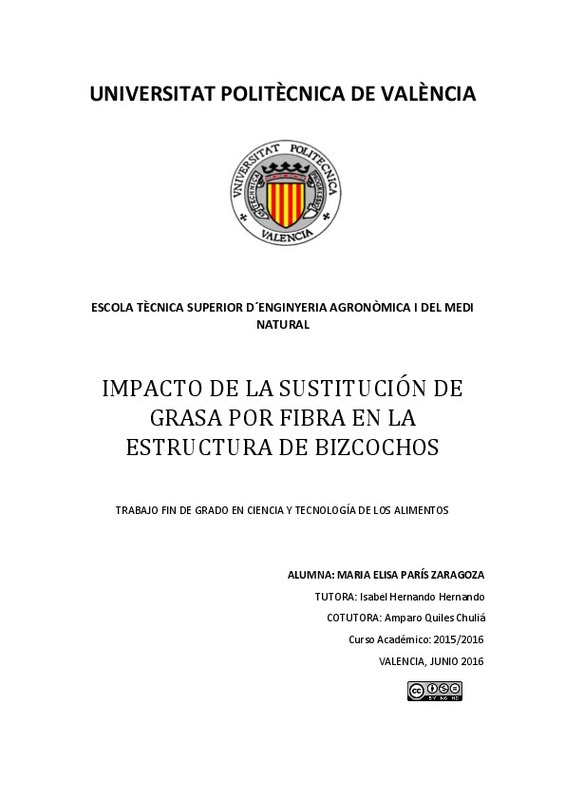|
Resumen:
|
[ES] En un contexto social en el que cada vez predominan más las enfermedades causadas por el
excesivo consumo de calorías y el déficit de fibra en la dieta, los consumidores empiezan a
valorar de forma más positiva los ...[+]
[ES] En un contexto social en el que cada vez predominan más las enfermedades causadas por el
excesivo consumo de calorías y el déficit de fibra en la dieta, los consumidores empiezan a
valorar de forma más positiva los alimentos saludables y bajos en grasa. Debido a la relación
que existe entre la alimentación y la salud, se ha estudiado la reformulación de bizcochos para
disminuir su contenido lipídico. En el presente trabajo se ha evaluado el efecto de la
sustitución del 50% de la grasa por fibras en la formulación de bizcochos. Las fibras que han
sido empleadas son; Vitacel KF 200, ingrediente natural procedente de la fibra de patata, rico
en fibra insoluble (FI), Fibersol-2, que es una maltodextrina resistente y es considerada rica en
fibra soluble (FS) y una mezcla a partes iguales de ambas fibras (M). Para ello se analizó las
propiedades de las masas de los bizcochos, evaluándose la viscosidad aparente y la estructura
por microscopía óptica. En la viscosidad aparente se obtuvieron resultados de menor
viscosidad cuando se añadió fibra, debido a que la fibra era necesaria hidratarla con agua, lo
que provocaba una disminución de la viscosidad. En la microscopía óptica se observó que la
grasa actúa de estabilizante de las burbujas de aire, formando una película en la interfaz airematriz,
mientras que la sustitución parcial de grasa provoca una disminución de la estabilidad,
coalesciendo las burbujas y formando canales de difusión, los cuales se observan en la
estructura macroscópica de la miga. La formulación FI presentó mayor cantidad de canales de
difusión y un porcentaje mayor de aire ocluido en el interior. Junto con la estructura
macroscópica de la miga de los bizcochos, se analizó también la textura y la microestructura
por microscopía electrónica de barrido de emisión de campo (FESEM) y se realizó la digestión
in vitro. En la textura de los bizcochos se obtuvo que las propiedades de dureza y
masticabilidad aumentaban notablemente en la formulación M y FI, mientras que la
formulación FS se mantenía igual que la formulación control (C). A nivel microestructural, se
apreció que la estructura de los bizcochos con fibra era más compacta. Los resultados de la
digestión in vitro mostraron que la formulación FS contenía mayor cantidad de almidón
resistente que las demás formulaciones.
[-]
[EN] In a social context in which diseases are more prominent caused by the excessive calorie
intake and the lack of fibre in the diet, consumers value healthy and low fat foods more
positively. Because of the relation ...[+]
[EN] In a social context in which diseases are more prominent caused by the excessive calorie
intake and the lack of fibre in the diet, consumers value healthy and low fat foods more
positively. Because of the relation between food and health, cakes reformulation have been
studied to decrease its lipid content. In this study, the effect of replacing 50% of the fat with
fibre in the formulation of cakes have been evaluated. The fibres that have been used are;
Vitacel KF 200, a natural ingredient from the potato fibre, rich in insoluble fibre (FI), Fibersol-2,
resistant maltodextrin and is considered as rich in soluble fibre (FS) and a mixture of equal
parts of both fibres (M). To achieve it, the properties of the cake batter was analysed,
evaluating the apparent viscosity and the structure by optical microscopy. Apparent viscosity
results in lower viscosity were obtained when fibre was added, because fibre was necessary to
hydrate with water, which was causing a decrease in viscosity. The optical microscopy shows
that fat acts as stabilizing air bubbles, forming a film at the air-matrix, while partial fat
replacement results in decreased stability, coalescing and forming diffusion partways, which
are observed in the macroscopic structure of the crumb. The FI formulation obtained the
biggest amount of distribution partways and a higher percentage of air occluded inside. Along
with the macroscopic structure of the crumb, the texture and microstructure by field emission
scanning electron microscope (FESEM) was also analysed, and the changes in the starch
digestibility with the in vitro digestion. In the texture of the cakes, chewiness and hardness
properties increased with the M and FI formulation, while FS was the same as C formulation. A
microstructural level showed that the structure of the cakes with fibre it was more compact.
The results of in vitro digestion showed that FS contained as much resistant starch as other
formulations.
[-]
|







